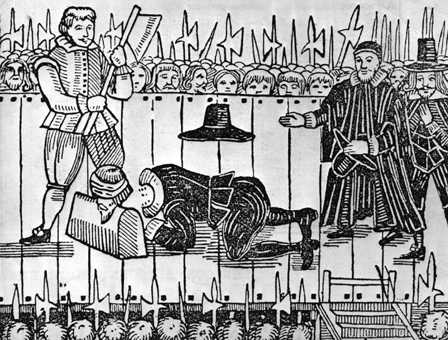Just raise your hand to signal when you’re ready.The death warrant of King Charles I required that he be put to death by the severing of his head from his body between the hours of ten in the morning and five in the afternoon on Tuesday, January 30, 1649. On the day before, he was allowed a farwell visit from two of his children; Princess Elizabeth, a plain serious girl of thirteen, and Henry, Duke of Gloucester, a lively eight year old.

This woodcut, printed in 1649, is dramatic but inaccurate. The headsman actually wore a mask, a wig, and a thick false beard.
Charles spoke first to Elizabeth, who was crying bitterly. He had much of importance to say to her that he could say to no one else. He was anxious, not without cause, about adolescent jealousy between his two elder sons. She was to tell ”her brother James, whenever she should see him, that it was her father’s last desire, that he should no more look upon Charles as his eldest brother only, but be obedient unto him as a sovereign. ”
A fearful silence had now fallen on the little knot of people on the scaffold, on the surrounding troops, and on the crowd. Within a few seconds the King stretched out his hands and the executioner on the instant and at one blow severed his head from his body. A boy of seventeen, standing a long way off in the throng, saw the axe fall. He would remember as long as he lived the sound that broke from the crowd; ”such a groan as I never heard before, and desire I may ever hear again”.

''The corpse of the King was transported to the embalmer, then kept at St. James Palace for a week. During that time, according to one story, a mysterious figure dressed in a cloak and muffler approached the coffin of Charles I and was heard to remark, “Cruel necessity.” Witnesses claimed that the voice and the walk of the cloaked man matched those of Oliver Cromwell.''
Charles sat up reading and praying until nearly midnight, and then slept peacefully. At about six o’clock he rose, claiming, ”having a great deal of work to do this day”. The bitter January frost was still unbroken, and he put on two shirts so that he would not shiver when he came to the block and so give an impression of fear. At about ten o’clock, troops came for him, and, to the sound of beating drums, he was marched to Whitehall Palace. There followed a cruel delay of three hours while the House of Commons hurried through a bill making it illegal to proclaim a new king.

''“Cromwell lifting the Coffin-lid and looking at the body of Charles I”, by Hippolyte (Paul) Delaroche — a French painter with an affinity for English execution scenes. The painting is based on an apocryphal but irresistible legend, also used by Nathaniel Hawthorne in a tedious short story.''
The one beautiful palace had for some time been occupied by the army, and it was gloomy and bare. Charles walked through the Banqueting Hall, whose ceiling, painted for him by Rubens, represented the triumph of wisdom and justice over rebellion and falsehood; passed through one of the windows, and so came to the scaffold, which had been built against the palace wall. The site had been chosen because it was a great deal more easily guarded than the usual places of public execution like Tower Hill or Tyburn.

''Handmade oil painting reproduction of Execution of Charles I (1600-49) at Whitehall, January 30th, 1649, a painting by Gonzales Coques.''
Large crowds had been waiting since early morning, but mounted troops formed a barrier between them and the scaffold, and Charles saw at one that it would be impossible to speak to them. Taking some notes from his pocket, he addressed himself instead to the group on the scaffold; soldiers, two colonels, several short hand writers, the executioner and his assistant, and Bishop Juxon. Attesting to his innocence, he asked God to forgive his enemies and care for the people.
To the executioner, Charles explained that he would pray briefly and then sign for him to strike. Looking at the block, which was only ten inches from the ground, he asked if it could not be raised. The reason for the low block was to make the execution easier to perform if he had offered any resistance. ”It can be no higher sir,” said the executioner, naturally unwilling to explain this. The King stood for a moment in prayer and then lay down with his nec
the block. The executioner bent down to make sure that his hair was not in the way, and Charles, thinking that he was preparing to strike, said ”Stay for the sign”. I will, an’ it please your Majesty”, said the executioner.
A fearful silence had now fallen on the little knot of people on the scaffold, on the surrounding troops, and on the crowd. Within a few seconds the King stretched out his hands and,
”The executioner beheaded him with one stroke of his axe. At the instant of the lethal stroke, one witness recorded, the crowd made “such a groan as I never heard before, and desire I may never hear again.” The mounted troopers moved forward to clear off the spectators, but some determined individuals managed to get through and dipped their handkerchiefs in the dead king’s blood. Others carried away soil from under the scaffold.”









 COMMENTS
COMMENTS



